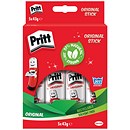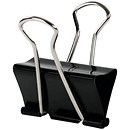Desktop Essentials
What are desktop essentials?
The lines between stationery, office supplies and so on are blurry but we use the term desktop essentials to refer to those items on or around your desktop that you use every day at the office and often at home. On this page you'll find glue, staplers, rubber bands, hole punches, scissors and more, often with products from household names like Blu-tack, Post-it Note, Pritt Stick, Sellotape and Tippex. These everyday objects have become part of everyday life, not just the workplace, and all have intricate histories relating to social change, consumer society and the changing demands of modern life.
Desktop essentials at Paperstone
- Office glue. From Pritt Sticks to Super Glue andBlu-tack
- Desk organisers. Desk mats, desk tidies, drawer sets and more
- Hole punches
- Office pins, clips and bands. Paper clips, elastic bands, et al.
- Post-it Notes
- Office scissors
- Rubber stamp supplies. Stamps and inks
- Staplers
- Office tapes, Sellotape
The history of stationery in general is intricately tied to the history of literacy, which in turn developed in the context of bureaucratic functions of government and the spread of religion. The written language with its need for writing implements and stuff to write on became a tool of kings and ruling classes who needed to record property and write laws. Equally, the written language was used to store knowledge and spread the word of religion by scribes and proselytisers. As the writing and reading of language spread, the demands of scribes and bureaucrats became more sophisticated. Printing developments radically accelerated the spread of literacy as associated innovations ushered new technologies into the world.
Early antecedents to desk accessories themselves can be found in, for example, the official seal whose function is broadly continued today by the (rubber) stamp. Other desk accessories like pins, scissors and glue borrow from other lineages, like cloth-making and arts and crafts. But it wasn't until the nineteenth century that desk accessories came into their own.
Firstly, there was a growing use of paper. The ever expanding state with its growing personnel logged and filed the populus in newly emerging government offices in ever more diverse ways. But the use of paper wasn't just growing in official circles but increasingly in schools and homes. Cheap paper-making techniques enabled more and more (predominantly middle class) people to keep diaries and write letters. Secondly, the industrial revolution afforded new modes of production, which in turn allowed the mass manufacture of goods. The second half of the nineteenth century saw a score of patents for devices that would develop into the desk accessories with which we are familiar today, such as staplers, hole punches, rubber bands and paper clips. Mass production meant that such devices could be manufactured on a wide scale.
The individual histories of particular office tools are of course much more complex and we're working on writing a few ourselves for this site. In the meantime, if you are interested in the history of particular office items, visit the excellent Early Office Museum for detailed and illustrated accounts.





























